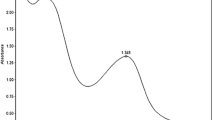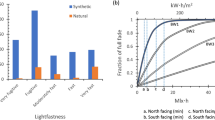Abstract
Quantitative HPLC and colorimetry are used to study color variations in dyeings with indigo, 6-bromoindigo, and 6,6′-dibromoindigo, the main components of the historic dye Tyrian purple. For the first time, visible light is identified conclusively as a cause of debromination of the leuco form of 6-bromoindigo. A dyeing run using 6-bromoindigo alone is found to yield a dyed fabric containing large amounts of indigo, when the vat is exposed to visible light. The extent of debromination is dependent upon the pH of the dye bath and also the source of the visible light. This information allowed development of a dyeing procedure which is demonstrated to give consistent colors through two passes. Quantitative HPLC analysis of extracts from the dyed fabrics indicates that the leuco form of 6-bromoindigo vs. the leuco forms of indigo and 6,6′-dibromoindigo has the strongest affinity for wool fabric. This is postulated to be due to attractive electrostatic interactions between the leuco form of 6-bromoindigo and wool.



Similar content being viewed by others
References
Lavinda O, Mironova I, Karimi S, Pozzi F, Samson J, Ajiki H, Massa L, Ramig K (2013) Singular thermochromic effects in dyeings with indigo, 6-bromoindigo, and 6,6'-dibromoindigo. Dyes Pigments 96:581–589
Ramig K, Lavinda O, Szalda DJ, Mironova I, Karimi S, Pozzi F, Shah N, Samson J, Ajiki H, Massa L, Mantzouris D, Karapanagiotis I, Cooksey C (2015) The nature of thermochromic effects in dyeings with indigo, 6-bromoindigo, and 6,6′-dibromoindigo, components of Tyrian purple. Dyes Pigments 117:37–48
Baig GA (2011) Indigo dyeing of polyester (PET) – pH effects. J Text I 102:87–92
Driessen LA (1944) Über eine charakteristische Reaktion des antiken Purpurs auf der Faser. Melliand Textilberichte 25:66
Van Alphen J (1944) Remarks on the action of light on several substances, most of them containing halogen, in particular several indigo dyes, in a reducing medium. Recl Trav Chim Pay-B 63:95–96
Pfister R (1937) Nouveaux textiles de Palmyre. Les Editions d'Art et d'Histoire, Paris, p. 12
Hofmann-de Keijzer R, van Bommel MR (2008) Dyestuff analysis of two textile fragments from late antiquity. Dyes in History and Archaeology 21:17–25
Bruni S, Guglielmi V, Pozzi F (2010) Surface-enhanced Raman spectroscopy (SERS) on silver colloids for the identification of ancient textile dyes: Tyrian purple and madder. J Raman Spectrosc 41:175–180
McGovern PE, Michel RH (1985) Royal purple dye: tracing the chemical origins of the industry. Anal Chem 57:1514A–1522A
Cooksey CJ, Sinclair RS (2005) Colour variations in Tyrian purple dyeing. Dyes in History and Archaeology 20:127–135
Voss G, Schramm W (2000) Selectively C-deuterated indigotins. Helv Chim Acta 83:2884–2892
Koren ZC (2008) A new HPLC-PDA method for the analysis of Tyrian purple components. Dyes in History and Archaeology 21:26–35
Sawada T, Ishii H, Ichikawa H, Watanabe K, Aoki J, Ueda T (2011) Development of vat-dyeing method using 6,6'-dibromoindigo and prevention of photodebromination. Nippon Silk Gakkaishi (Journal of Silk Science and Technology of Japan) 19:15–21
Friedländer P (1909) Über den Farbstoff des antiken Purpurs aus Murex brandaris. Ber Dtsch Chem Ges 42:765–770
Friedländer P (1922) Über die Farbstoffe aus Purpura aperta und Purpura lapillus. Ber Dtsch Chem Ges 55:1655–1658
Wouters J (1992) A new method for the analysis of blue and purple dyes in textiles. Dyes in History and Archaeology 10:17–21
Cooksey CJ (2001) Tyrian purple: 6,6'-dibromoindigo and related compounds. Molecules 6:736–769
Cardon D (2007) Natural dyes: sources, tradition, technology and science. Archetype Publications, pp:551–606
Terada T (2008) Sea snail purple in contemporary Japanese embroidery. Textile Society of America 11th Biennial Symposium: Textiles as Cultural Expressions, Honolulu, Hawai'i, paper 138
Surowiec I, Nowik W, Moritz T (2012) Mass spectrometric identification of new minor indigoids in shellfish purple dye from Hexaplex trunculus. Dyes Pigments 94:363–369
Cooksey C (2013) Tyrian purple: the first four thousand years. Sci Prog 96:171–186
Karapanagiotis I, Mantzouris D, Cooksey C, Mubarak MS, Tsiamyrtzis P (2013) An improved HPLC method coupled to PCA for the identification of Tyrian purple in archaeological and historical samples. Microchem J 110:70–80
Mantzouris D, Karapanagiotis I (2014) Identification of indirubin and monobromoindirubins in Murex brandaris. Dyes Pigments 104:194–196
Clark RJH, Cooksey CJ (1999) Monobromoindigos: a new general synthesis, the characterization of all four isomers and an investigation into the purple colour of 6,6'-dibromoindigo. New J Chem 23:323–328
Koren ZC (2005) The first optimal all-murex all-natural purple dyeing in the eastern Mediterranean in a millennium and a half. Dyes in History and Archaeology 20:136–149
Koren ZC (2006) HPLC-PDA analysis of brominated indirubinoid, indigoid, and isatinoid dyes. In: Meijer L, Guyard N, Skaltsounis L, Eisenbrand G (eds) Indirubin, the red shade of indigo. Life in Progress Editions, Roscoff, pp. 45–53
McGovern PE, Michel RH (1990) Royal Purple dye: the chemical reconstruction of the ancient Mediterranean industry. Accounts Chem Res 23:152–158
Padden AN, Dillon VM, Edmonds J, Collins MD, Alvarez N, John P (1999) An indigo-reducing moderate thermophile from a woad vat, Clostridium isatidis sp. nov. Int J Syst Evol Micr 49:1025–1031
Yumoto I, Hirota K, Nodasaka Y, Tokiwa Y, Nakajima K (2008) Alkalibacterium indicireducens sp. nov., an obligate alkaliphile that reduces indigo dye. Int J Syst Evol Micr 58:901–905
Edmonds J (2000) Tyrian or imperial purple dye, Historic dye series no. 7, ISBN 0 9534133 65, self-published
Kanold IB (2005) The purple fermentation vat: dyeing or painting parchment with Murex trunculus. Dyes in History and Archaeology 20:150–154
Koren ZC (2012) Chromatographic and colorimetric characterizations of brominated indigoid dyeings. Dyes Pigments 95:491–501
Vasileiadou A, Karapanagiotis I, Zotou A (2016) Determination of Tyrian purple by high performance liquid chromatography with diode array detection. J Chromatogr A 1448:67–72
Frisch MJ, Trucks GW, Schlegel HB, Scuseria GE, Robb MA, Cheeseman JR, Scalmani G, Barone V, Petersson GA, Nakatsuji H, Li X, Caricato M, Marenich AV, Bloino J, Janesko BG, Gomperts R, Mennucci B, Hratchian HP, Ortiz JV, Izmaylov AF, Sonnenberg JL, Williams-Young D, Ding F, Lipparini F, Egidi F, Goings J, Peng B, Petrone A, Henderson T, Ranasinghe D, Zakrzewski VG, Gao J, Rega N, Zheng G, Liang W, Hada M, Ehara M, Toyota K, Fukuda R, Hasegawa J, Ishida M, Nakajima T, Honda Y, Kitao O, Nakai H, Vreven T, Throssell K, Montgomery Jr JA, Peralta JE, Ogliaro F, Bearpark MJ, Heyd JJ, Brothers EN, Kudin KN, Staroverov VN, Keith TA, Kobayashi R, Normand J, Raghavachari K, Rendell AP, Burant JC, Iyengar SS, Tomasi J, Cossi M, Millam JM, Klene M, Adamo C, Cammi R, Ochterski JW, Martin RL, Morokuma K, Farkas O, Foresman JB, Fox DJ (2016) Gaussian 09, Revision E.01. Gaussian, Inc., Wallingford CT, USA
Tanoue Y, Terada A, Sakata K, Hashimoto M, Morishita SI, Hamada M, Kai N, Nagai T (2001) A facile synthesis of Tyrian purple based on a biosynthetic pathway. Fisheries Sci 67:726–729
Cooksey CJ (1995) Making Tyrian purple. Dyes in History and Archaeology 13:7–13
Schanda J (2007) CIE colorimetry. In: Schanda J (ed) Colorimetry understanding the CIE system. Wiley, Hoboken, pp. 58–64
Karapanagiotis I, de Villemereuil V, Magiatis P, Polychronopoulos P, Vougogiannopoulou K, Skaltsounis A-L (2006) Identification of the coloring constituents of four natural indigoid dyes. J Liq Chromatogr Rel Tech 29:1491–1502
Acknowledgments
Ms. Jo Kirby, formerly of The National Gallery, London, and Mr. Greg Rohaus of Konica Minolta are thanked for helpful discussions. Dr. Frank Jacob of Queensborough Community College is thanked for translating articles in Japanese. Akn Fabrics Inc. is thanked for supplying the wool fabric.
Author information
Authors and Affiliations
Corresponding authors
Ethics declarations
Conflict of interest
The authors declare that they have no conflict of interest.
Additional information
This article is dedicated to our colleague and friend Professor Lou Massa, in honor of his 75th birthday. Lou kindly introduced this project to three of us (KR, OL, and SK) and collaborated in much of the previous work on it.
Electronic supplementary material
ESM 1
(PDF 38.9 kb)
Rights and permissions
About this article
Cite this article
Ramig, K., Islamova, A., Scalise, J. et al. The effect of light and dye composition on the color of dyeings with indigo, 6-bromoindigo, and 6,6′-dibromoindigo, components of Tyrian purple. Struct Chem 28, 1553–1561 (2017). https://doi.org/10.1007/s11224-017-0932-0
Received:
Accepted:
Published:
Issue Date:
DOI: https://doi.org/10.1007/s11224-017-0932-0




